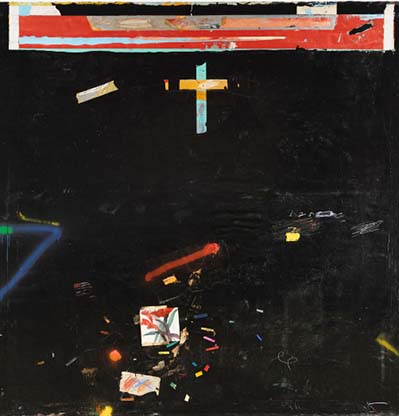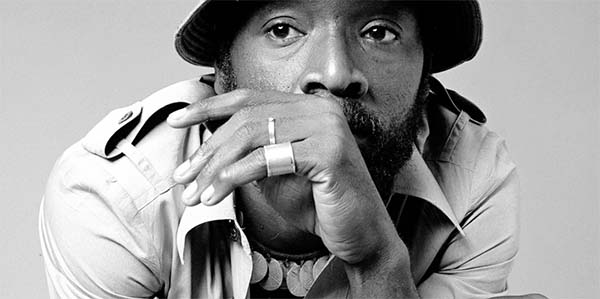레이몬드 손더스(Raymond Saunders) 'Post No Bills' @앤드류크렙스(2/22-4/6)
RAYMOND SAUNDERS
Post No Bills
Andrew Kreps: 22 Cortlandt Alley
February 22 – April 6, 2024

Raymond Saunders, I Don't Go To Church Anymore, 1975, Painting and mixed media on canvas, 86 x 83 1/2 x 2 1/4 inches (218.4 x 212.1 x 5.7 cm.)
February 7, 2024 – Andrew Kreps is pleased to announce co-representation of American artist Raymond Saunders (b. 1934) with David Zwirner. A two-part solo exhibition curated by Ebony L. Haynes will open on February 22 at David Zwirner’s 519 and 525 West 19th Street galleries in Chelsea and Andrew Kreps’s gallery at 22 Cortlandt Alley in Tribeca. Titled Post No Bills, this expansive presentation will span four decades of the artist’s work. Including paintings and works on paper, many of which have never before been seen, this exhibition offers visitors insight into Saunders’s singular and influential practice.
In his works, Saunders brings together his extensive formal training with his own observations and lived experience. His assemblage-style paintings frequently begin with a monochromatic black ground elaborated with white chalk—both a pointed reversal of the traditional figure-ground relationship and a nod to Saunders’s decades spent as a teacher. He subsequently adds a range of other markings, materials, and talismans. Expressionistic swaths of paint, minimalist motifs, line drawings, and passages of vibrant color tangle with found objects, signs, and doors collected from his urban environment, creating unexpected visual rhymes and resonances that reward careful and sustained looking. At once deliberately constructed and improvisatory, didactic and deeply felt, these richly built surfaces conjure the fullness of life, and its complications, allowing for a vast and nuanced multiplicity of meanings.
Saunders’s singular aesthetic finds echoes in the work of artists ranging from Cy Twombly and Robert Rauschenberg to Joseph Beuys and Jean-Michel Basquiat—all roughly working in parallel—but remains unmistakably his own. As curator Connie H. Choi of The Studio Museum in Harlem describes, “Sights and sounds pass by as one moves along a city street, encountering the world, making decisions, and changing one’s mind as one goes. Such is the beauty of Saunders’s paintings. They are about life and all of its battles and victories, dirtiness and splendor.” David Zwirner states, “Andrew reached out to me late last year to introduce me to the work of Raymond Saunders, and I was mesmerized immediately. Seeing the oil work in Andrew’s gallery I felt I was in the presence of a major American voice in painting, who has not received his proper due. Saunders’s work connects some of the most important American schools, such as expressionism, minimalism, and assemblage, all the while effortlessly blurring boundaries between abstraction and figuration with great poetic energy. I’m thankful to Andrew for reaching out, and I am grateful to Ebony L. Haynes for having such interest in the work and her excitement in curating this major two-gallery show. I feel strongly that his work deserves a much wider audience”
Andrew Kreps states, “I’m thrilled to be able to collaborate with David to share Raymond Saunders’s extraordinary contributions to art history. There’s no question that Raymond has yet to have his proper due, and I believe these concurrent exhibitions, one of the most expansive presentations of his work to date, will make it clear how profound and rich his practice is. I can’t think of another artist who is able to so effortlessly pull together such a wide range of mark-making and materiality, with each work becoming its own world.”
About the Exhibition:
On view at David Zwirner’s 519 and 525 West 19th Street galleries in Chelsea and Andrew Kreps’s gallery at 22 Cortlandt Alley (with a second entrance at 394 Broadway) in Tribeca, the exhibition takes its title—Post No Bills—from a 1968 painting by Saunders that features a small rectangular patch of expressionistic brushstrokes collaged onto a vast red monochromatic background. This refrain, which recurs in later works, can be seen to encapsulate the artist’s incisive views on such wide-ranging themes as community, public space, art making, and visibility. In appropriating signage deliberately designed to keep communal surfaces bare and make way for paid advertisements and re-presenting it in the context of a work of art destined to be hung in a white cube, Saunders questions the inbuilt structures that dictate inclusion and exclusion, both in the public sphere and the art institution. On view will be a range of paintings and works on paper that embody this ethos, showcasing Saunders’s nuanced visual vocabulary that seamlessly traverses both high and low points of reference.
Ebony L. Haynes, the curator of this exhibition, states, “The opportunity to present the work of Raymond Saunders across two spaces has been extremely rewarding. Saunders’s singular practice spans decades and yet so much of the work has never been documented or exhibited widely. Post No Bills highlights Saunders’s intentional and effective formal style that blends painting, drawing and collage, and focuses on his consistent observations and questioning around belonging and visibility, and the quieted dissent of a formidable painter.”
"Raymond Saunders reconstructs reality for us and with us. We discover with a shock how much of the world's beauty lies in iits detritus...Glorious."
-Tony Morrison

Raymond Saunders, 1970s
About the Artist:
Born in 1934 in Pittsburgh, Raymond Saunders first studied art in the city’s public schools, participating in a program for artistically gifted students. His mentor, Joseph C. Fitzpatrick, the director of art for Pittsburgh public schools, also taught artists including Andy Warhol, Philip Pearlstein, and Mel Bochner. Through Fitzpatrick’s support and encouragement, Saunders earned a scholarship to the Pennsylvania Academy of Fine Arts in Philadelphia, also taking courses at the Barnes Foundation organized through the University of Pennsylvania, before returning to Pittsburgh and earning his BFA from the Carnegie Institute of Technology in 1960. He subsequently earned an MFA from the California College of Arts and Crafts in Oakland in 1961. In 1968, he accepted a teaching position at California State University, Hayward, eventually joining the faculty of his alma mater (now California College of the Arts), where he remains professor emeritus.
In 1967, Saunders achieved wide recognition when he published the pamphlet Black Is a Color as a rebuttal to an article by the writer Ishmael Reed about the Black Arts Movement. In this text, Saunders argues powerfully that Reed fails to capture the vastness of Black expression and in doing so siloes Black artists and their work as delimited by the category of race alone. He concludes with the imperative that we necessarily separate identity from artistic output, that “we get clear of these degrading limitations, and recognize the wider reality of art, where color is the means, not the end.”
The first solo exhibitions of Saunders’s works were held at the Terry Dintenfass Gallery in New York (1966; 1969; 1970; 1972). In 1971, the artist was the subject of his first West Coast exhibition and first major museum presentation, at the San Francisco Museum of Modern Art, which was also shown at Terry Dintenfass Gallery, New York. Saunders exhibited widely across the United States and in Europe, with solo exhibitions at the Providence Museum of Art, Rhode Island (1972); Pennsylvania Academy of Fine Arts, Philadelphia (1974; 1990); University Art Museum, University of California, Berkeley (1976); Stephen Wirtz Gallery, San Francisco (1979, traveled to Baum/Silverman Gallery, Los Angeles), and Terry Dintenfass Gallery, New York; 1980; 1982; 1985; 1987; 1989; 1991; 1993; 1996; 1999); Seattle Art Museum (1981); Los Angeles Municipal Art Gallery (1984); Addison Gallery of American Art, Andover, Massachusetts (1987; 1989); Galerie Resche, Paris (1990; 1993); Tampa Museum of Art, Florida (1992); Oakland Museum (1994); Phoenix Art Museum (1994); Giorgio de Chirico Art Centre, Voros, Greece (1995); M. H. de Young Memorial Museum, San Francisco (1995); the American Embassy in Ouagadougou, Burkina Faso (1996); Carnegie Museum of Art, Pittsburgh (1996); Miami University Art Museum, Oxford, Ohio (1996); and the Hunter College Gallery / Times Square, City University of New York (1998). The artist also participated in the 1972 Whitney Biennial.
Over the last two decades, Saunders has continued to be the subject of solo exhibitions globally, in addition to appearing in several notable group exhibitions. In 2011, Saunders was included in Now Dig This! Art and Black Los Angeles 1960–1980, curated by Kellie Jones at the Hammer Museum, Los Angeles, which traveled to MoMA PS1, New York, and Williams College Museum of Art, Williamstown, Massachusetts. In 2017, the artist was included in Soul of a Nation: Art in the Age of Black Power at Tate, London, which traveled to Crystal Bridges Museum of American Art, Bentonville, Arkansas, and The Broad, Los Angeles; and in 2022, his work appeared in the exhibition Just Above Midtown: Changing Spaces at The Museum of Modern Art, New York.
In 2021, Andrew Kreps Gallery and Casemore Gallery organized the two-part solo exhibition 40 Years: Paris/Oakland in San Francisco, which spanned four decades of the artist’s career. The following year, Andrew Kreps Gallery presented the first exhibition of Saunders’ work in New York since 1998. Andrew Kreps Gallery has represented Raymond Saunders since 2021.
Saunders has been the recipient of honors such as a National Institute of Arts and Letters Award (1963), a Ford Foundation Award (1964), a Rome Prize Fellowship (1964), a Guggenheim Fellowship (1976), and two National Endowment for the Arts Awards (1977, 1984).
Work by the artist is held in numerous public collections, including the Addison Gallery of American Art, Andover, Massachusetts; Berkeley Art Museum and Pacific Film Archive, University of California, Berkeley; California College of Arts and Crafts, Oakland; Carnegie Museum of Art, Pittsburgh; Chrysler Museum of Art, Norfolk, Virginia; Corcoran Gallery of Art, Washington, DC; Crocker Art Museum, Sacramento; The Metropolitan Museum of Art, New York; M. H. de Young and Legion of Honor, Fine Arts Museums of San Francisco; Museum Brandhorst, Munich; Museum of Contemporary Art, Los Angeles; The Museum of Modern Art, New York; National Gallery of Art, Washington, DC; Philadelphia Museum of Art; Phoenix Art Museum; Portland Art Museum, Oregon; Saint Louis Museum of Fine Arts; San Francisco Museum of Modern Art; Seattle Art Museum; Walker Art Center, Minneapolis; and the Whitney Museum of American Art, New York, among others. He lives and works in Oakland.





